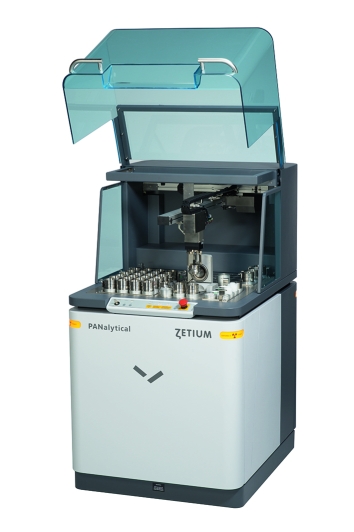Mar 9 2015
In a significant announcement at Pittcon 2015, PANalytical has revealed a revolution in X-ray fluorescence spectrometry. With up to three complementary technologies on one multi-functional XRF platform, the new Zetium is set to change the way scientists think about XRF analysis.
 Zetium spectrometer provides elemental excellence in material insight
Zetium spectrometer provides elemental excellence in material insight
The measurement platform of Zetium holds both wavelength dispersive (WD) and energy dispersive (ED) cores integrated by SumXcore technology in one instrument. Zetium can also include a small spot analysis tool for fast element distribution mapping, and the innovative THETA free lime channel for dedicated cement applications.
This unique combination of technologies not only matches the traditional needs of XRF users, but offers a range of new possibilities. For example, measuring ED- and WDXRF simultaneously collects all the data on a sample in one run, cutting experimental time in up to half compared to running two sequential analyses.
For industry-specific challenges such as those found in cement production, the ability to make traditional XRF measurements and assess free lime in the same system delivers clear advantages.
Importantly, whatever the application, Zetium is designed to set new standards in terms of analytical power, usability and sustainability, to users in process optimization, quality control and research. Zetium is the successor to PANalytical’s highly successful Axios range of spectrometers and this heritage of proven technology underpins the new analytical platform.
To make system selection straightforward, PANalytical has created a series of dedicated Zetium editions. There are five specific Industry editions: Cement, Polymers, Petro, Metals and Minerals, as well as an ‘Ultimate’ edition. Each is available with a choice of four enhanced performance packages for: improved speed and throughput, performance enhancement, robustness and uptime, and flexibility.
The hardware advances in Zetium have been matched by an enhanced software framework and user interface. SumXcore technology is the software and hardware at the heart of Zetium, integrating the system’s cores to deliver advanced performance coupled with maximum task flexibility. Ease of use for even non-expert users has been prioritized through the intuitive, task-oriented user interface and the integrated intelligence of the Virtual Analyst, which provides guidance on the optimal setup for each experiment.
Zetium offers a unique combination of possibilities that put it in a class of its own for analytical power, speed and task flexibility. The system has been designed from the ground up to allow customers to take full advantage of all our innovations. Zetium is a great demonstration of PANalytical’s philosophy of elemental excellence – our focus is firmly on providing the best tools to help our users excel within their businesses.
Simon Milner, Product Marketing Manager for XRF, PANalytical
For more information about Zetium, visit www.panalytical.com/zetium
About PANalytical
PANalytical’s mission is to enable people to get valuable insight into their materials and processes. Our customers can be found in virtually every industry segment, from building materials to pharmaceuticals and from metals and mining to nanomaterials. The combination of our software and instrumentation, based on X-ray diffraction (XRD), X-ray fluorescence (XRF) and near-infrared (NIR) spectroscopy as well as pulsed fast thermal neutron activation (PFTNA), provides our customers with highly reliable and robust elemental and structural information on their materials and is applied in scientific research and industrial process and quality control.
PANalytical employs over 1,000 people worldwide. The company’s headquarters are in Almelo, the Netherlands. Fully equipped application laboratories are established in Japan, China, the US, Brazil, and the Netherlands. PANalytical’s research activities are based in Almelo (NL) and on the campus of the University of Sussex in Brighton (UK). Supply and competence centers are located on two sites in the Netherlands: Almelo (X-ray instruments) and Eindhoven (X-ray tubes), in Nottingham, UK (XRF applications and standards), in Quebec, Canada (fusion sample preparation) and in Boulder CO, US (near-infrared instruments).